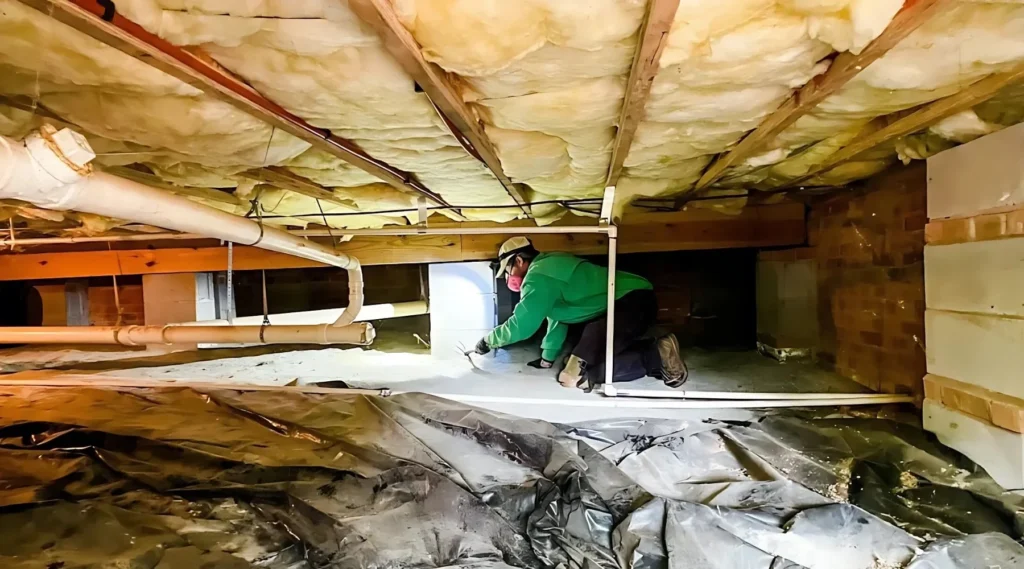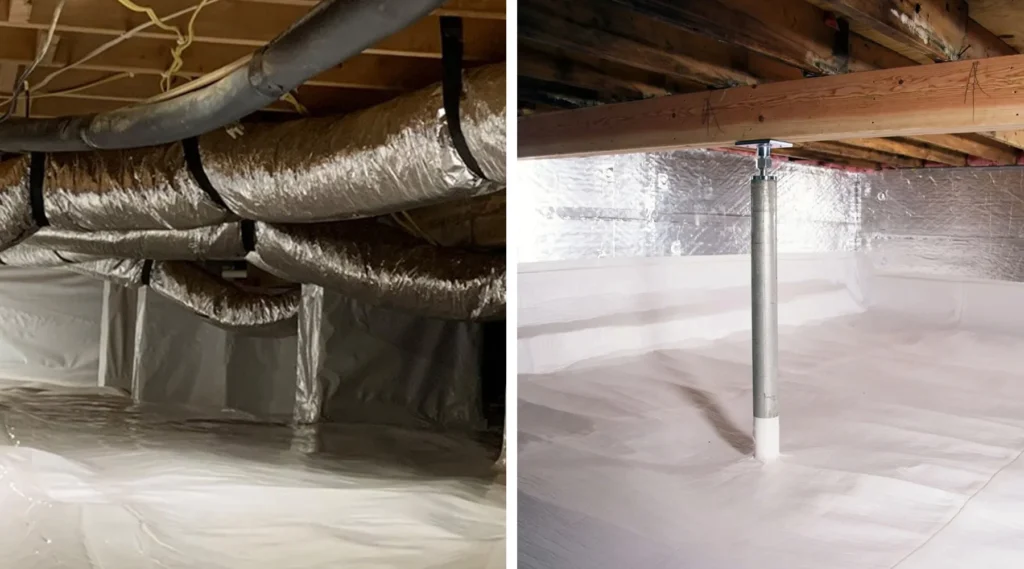If you’ve peeked into your crawl space and spotted fuzzy patches, dark spots, or smelled that unmistakable musty odor, you might be dealing with mold. And here’s the thing, crawl space mold isn’t just an eyesore. It can weaken wood structures, ruin insulation, and send unhealthy spores circulating through your home’s air.
The good news? Mold in a crawl space can be fixed, and even better, it can be prevented from coming back. The key is to take the safest, most effective approach from the start.
Below, we’ll walk you through what causes crawl space mold, how to handle it the right way, and why crawl space encapsulation and professional mold remediation are worth every penny.
Why Mold Loves Crawl Spaces
Crawl spaces naturally create a perfect storm for mold growth:
- Moisture: Water seeps in from the ground, plumbing leaks, or poor drainage.
- Poor ventilation: Stale, humid air sits there.
- Organic materials: Wood beams, joists, and insulation can act like a buffet for mold spores.
Once mold finds a damp, dark place with food, it spreads fast, sometimes within 24–48 hours. That’s why early action is critical.
How to Get Rid of Mold the Right Way?

Knowing why mold grows is important, but stopping it in its tracks requires a clear plan. The safest and most effective mold remediation starts with these essential steps.
Step 1: Identify the Source of Moisture
You can’t truly fix crawl space mold without fixing the moisture problem first. Otherwise, you’ll just be cleaning up mold over and over.
Common sources to check:
- Plumbing leaks
- Poor grading around the home
- Clogged gutters or downspouts
- Groundwater seepage
- Condensation from uninsulated ductwork
Pro Tip: If you’re unsure where the moisture is coming from, have a crawl space repair specialist inspect it. Professionals can spot hidden leaks or drainage issues you might miss.
Step 2: Safe Mold Removal Methods
Once moisture is under control, it’s time for mold removal. Here’s what safe, effective remediation usually involves:
1. Containment
Before any cleaning starts, the work area is sealed off. This prevents mould spores from drifting into the rest of your home.
2. HEPA Filtration
Special air scrubbers and vacuums with HEPA filters trap airborne spores, keeping the air clean during the process.
3. Physical Cleaning
Professionals scrub affected surfaces using wire brushes or sanding to remove visible mold.
4. Antimicrobial Treatments
Surfaces are treated with mold-killing solutions that penetrate wood fibers and prevent regrowth.
5. Debris Removal
Any ruined insulation, vapour barriers, or damaged wood is removed and replaced as needed.
Warning: Avoid DIY bleach treatments. While bleach may lighten stains, it often doesn’t penetrate porous wood enough to kill mold at the root.
Step 3: Prevent Mold from Returning
Once the mold is gone, the focus should shift to making sure it never comes back. That’s where crawl space encapsulation comes in.
What Is Crawl Space Encapsulation?
Encapsulation involves sealing the crawl space with a heavy-duty vapor barrier, insulating walls, and often adding a dehumidifier. It locks out moisture, pests, and outside air.
Benefits of Encapsulation for Mold Prevention:
- Keeps humidity levels stable year-round
- Blocks ground moisture from rising into the crawl space
- Improves indoor air quality
- Protects your home’s structure from rot
Additional Crawl Space Repair Solutions
Depending on your crawl space’s condition, other improvements might be needed alongside mold remediation:
- Sump pump installation to remove standing water
- French drains to improve groundwater flow away from your foundation
- Gutter extensions to keep rainwater from pooling near your home
- Insulation upgrades to reduce condensation
A well-planned crawl space repair strategy not only eliminates mold but also makes your home more energy-efficient and healthier.
When to Call a Professional
You might be tempted to tackle crawl space mold yourself, but here’s why professional mold remediation is safer and more effective:
- Health Risks: Mold exposure can trigger allergies, asthma, and other respiratory issues.
- Hidden Growth: Mold often hides in places you can’t easily see or reach.
- Special Equipment: Pros use commercial-grade HEPA vacuums, moisture meters, and antimicrobial agents you can’t get at the hardware store.
- Long-Term Results: Professionals address both the mold and the root cause, so it doesn’t return.
Cost vs. Risk: Why It’s Worth It
Trying to save money by skipping professional remediation can backfire. If mold returns, and it will if moisture remains, you could end up paying far more for repairs later. Worse, unchecked mold can cause:
- Structural damage to floor joists and beams
- Insulation replacement costs
- Increased energy bills from poor insulation
- Serious indoor air quality problems
Investing in proper mold removal and crawl space encapsulation now saves you from costly headaches down the road.
Final Thoughts
Mold in a crawl space isn’t something to ignore or put off. With the right approach, stopping moisture at its source, safely removing the mold, and sealing the space, you can protect your home’s structure and your family’s health.
At Tri-State Waterproofing, we’ve helped homeowners across Georgia, North Carolina, and South Carolina eliminate crawl space mold for good. Our team specializes in mold remediation, crawl space repair, commercial waterproofing, and encapsulation solutions that keep your home dry and healthy year-round.
Don’t wait until mold takes over. Call Tri-State Waterproofing today for a professional crawl space inspection and a customized plan to make your home safer, stronger, and mold-free.


